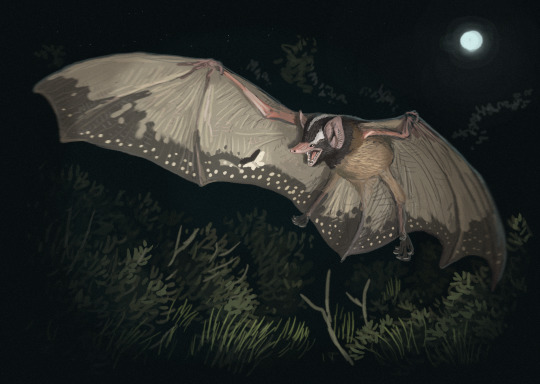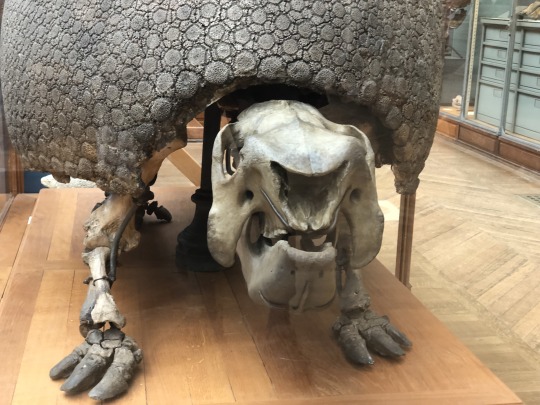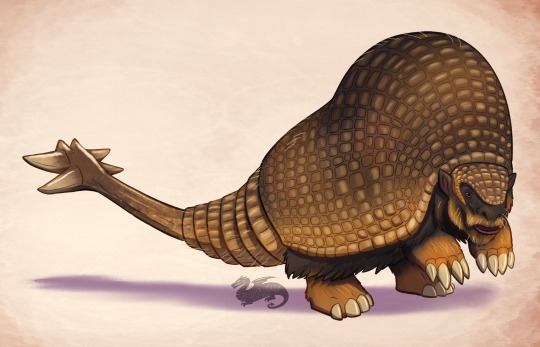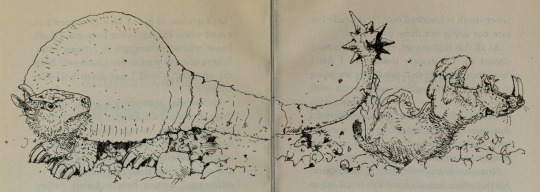#Glyptodonts
Text

Animal Ghosts. Edited by Claudia Clow. Illustrated by Walt Disney Productions. 1971.
Internet Archive
150 notes
·
View notes
Text




Results from the #paleostream
Synemporion, Megapterygius, Neosclerocalyptus and Trachytheuthis.
#sciart#paleoart#paleostream#palaeoblr#mosasaurs#jurassic#squid#cephalopod#bat#Synemporion#glyptodont
687 notes
·
View notes
Text



Face to face with God.
330 notes
·
View notes
Text

Paleovember 2022, Doedicurus!
A member of the glyptodonts (extinct relatives of the modern armadillo), Doedicurus seems to have taken a note from ankylosaurs when it came to its spiked tail. Despite it seemingly being front heavy, it’s weight was actually centered on its hips, meaning it could stand on its hind legs!
#Doedicurus#glyptodont#armadillo#pleistocene#ice age#paleontology#paleoart#Paleovember#illustration#art#artwork#digitalart#cartoon#drawing#creaturedesign#procreate#cenozoic#artist on tumblr
183 notes
·
View notes
Text

Drawing of two prehistoric men hunting a Glyptodon by Heinrich Harder
#prehistory#stone age#paleoart#anthropology#paleolithic#native american#indigenous people#glyptodont#glyptodon#heinrich harder
6 notes
·
View notes
Text


The lads, enemies for life
A fictional glyptodont (Glyptocube even) and a fictional giant terrorbird
65 notes
·
View notes
Text

Ancardia's Unusual Animals--the Tarasque
Classification: Beast (xenarthan)
Habitat: Forested and grassy valleys among Tvearban and the Northern Drakalors.
While widely reviled as a destructive and hideous monster in many old texts of the Hruunding, in modern times it is understood that the Tarasque is a relatively docile herbivorous relative of the anteaters and sloths of the Southern hemisphere which is only dangerous for its great size compared to other animals. The tarasque usually measures from 2.5 to 2.9 meters from head to tailtip and it usually weighs around 1,400 pounds due to its heavy armoring and thick bone structure. It spends much of its time browsing on legumes, tall grasses, and sometimes rearing higher to reach the branches of low maple and poplar trees. It is for most of the year a solitary beast, only migrating many miles at its own slow pace in the late autumn to find a suitable mate before entering a torpor state for about four weeks in a burrowed den or snow drift to wake to either a heavily-pregnant mate or a mate with a group of 3 to 6 newborn pups. The mother cares for the pups for the first four weeks or until they are successfully weaned, at which point the pups will all follow the father and rely upon him entirely for care. The father gathers new shoots and edible flowers for them in the spring as well as teaching the pups to socialize properly with other tarasque, and while the young tarasque grow more independent once they reach six months, the still return at various times to socialize and learn additional food sources from the parents.
The tarasque is now understood to be a seclusive and skittish herbivore (and not the rampaging monstrous carnivore it was once believed to be), mostly feeding on long grasses, heather, clover species and wild cranberry and dewberry fruits. It is also noted to enjoy vetches and the kudzu plant which, introduced from the Sivdoth Islands as an ornamental, threatens at some times to take over entire Akimmian towns in the southern areas. Tarasque are, in fact, not so difficult to tame as legends would suggest, and there is a booming business among the river hurthlings of Akimmia to trade tame Tarasque into the Buldar region to be a kudzu control animal in exchange for viable pack beasts like donkeys, desert ponies, and the odd camel. Wild tarasque are largely found mostly just south of Tvearban, where they feed mostly on Ice Age grasses and shrubs in between lands claimed mostly by mammoth and other arctic megafauna.
#ancardia#ancardian homebrew#bestiary#mixed media#creatures#animals#Ancient Domains of Mystery#ADOM#Dnd-like#Tarasque#glyptodont#xenarthan#French mythology#Turns out 'scares the locals' doesn't mean 'is unnaturally and irrevocably evil' when it comes to random rare critters at all
10 notes
·
View notes
Text
GLYPTODONT

Day 15: Armadillo
~~•~~
The Glyptodont is a cryptid that used to live in the Americas during the Pliocene Epoch. It’s status as a cryptid is based on the fact that some people believe it may still exist to this day.
#andjocie#art#artists on tumblr#artoftheday#cryptid#inktober#jocieart#traditional art#monster#ink art#glyptodon#glyptodont#dinosaur#dinos#extinct species#armadillo#inktober day 15
1 note
·
View note
Text

This is the preserved shell of a giant 'ancient armadillo' creature called Glyptodont that roamed the earth around 20,000 years ago. A farmer in Argentina uncovered four of them in a dried-out riverbed near Buenos Aires in February 2020.
More details/photos: https://hasanjasim.online/ancient-armadillo-the-size-of-a-car-discovered-in-argentina/
498 notes
·
View notes
Text

Secret Land of the Past. Written by Miriam Schlein. Illustrated by Kees de Kiefte. 1992.
Internet Archive
201 notes
·
View notes
Text

Another #paleostream sketch
Doedicurus, standing bipedally. There are actual publications that indicate that even these enormous armadillos were able to walk on their hind limbs. Also their osteoderms show openings for hair follicles, so their armor was partially furry.
216 notes
·
View notes
Text
Worldbuilding
If there’s anything I suck at more than anything in fiction, it’s world building.
So let’s get started.
The general idea of my sci fi world is that Earth has just joined the stars. While this is public knowledge, there is very little known about its dominating species, “humans.” However, Earth has been classified as a Class D planet.
Every planet in the universe can fall under certain labels and classifications based on their abilities to sustain life. N Class planets are incapable of sustaining life, and are what make up most of the universe. Whenever a planet with life is found, it is first classified by what kind of life inhabits it. The two options are sentient and non-sentient. Then, if sentience is recognized: advanced or primitive? A society becomes advanced when they have an established connection to technology.
If no sentient species is established, then the planet is analyzed for threat levels of wildlife and disease. This is their “danger class,” and trumps all other classes. If the danger class is high enough, it is then considered a “death planet” and thus is much too dangerous to land on.
The Interstellar Safety Commission is the governing body responsible for this, and publicizes information about such on all planets that are candidates for resource harvesting and/or colonization. They also do this for private companies who are hoping to mine out various planets.
This organization has existed for almost 30,000 years.
Earth was the subject of this classification just before human’s began building civilizations. At the time, not only did the federation find that the planet had, at one point, been hit by an asteroid, but that the planet was teeming with violent creatures. The federation was newer at the time, it’s many members being unfamiliar with the many shapes that life can take. Thus, sights like the glyptodonts and prehistoric hippos were new and unfathomably terrifying.
Because of the mass amount of planets across the universe, typically the solar system around a “death planet” will be quickly archived. Organizations that apply for legal planet mining can easily find new ones nowadays as tech has grown significantly since the start of the ISC. So Earth was largely forgotten, as was our solar system. So much so that our little corner of the Milky Way was one of many little things that was forgotten. This is a loophole that many exploit but that will be discussed later.
Because there was no observation of our planet after this, Earth was pretty much left to evolve in peace. 10,000 years later, it’s the year 2088 and Earth has joined the stars. Upon reviewing the planet we came from, the ISC was baffled by our ability to survive, much less evolve on what is largely considered a “death planet.” Due to this information being public, many rumors started about the human race. We’ve been amongst the stars for almost a decade, which is nothing in the great span of the universe.
Humans have barely begun diplomatic missions with the universe, as our tech is extremely primitive in comparison to most alien tech. This contributes to the grand mystery around humans.
The main misconception is that humans are naturally aggressive and deadly. They are also all huge, hulking creatures with sharp teeth and a kick like no other. As time passes in space, and we learn more about our place among the stars, many of us learn one great truth about our impression on the universe.
Humans.
Are space orcs.
#science fiction#writing inspiration#my writing#original post#sci fi writing#sci fi shitpost#sci fi and fantasy#i just love the humans are space orcs trope#humans are space orcs#humans are weird#humans are space australians#humans are space oddities#humans are deathworlders
237 notes
·
View notes
Text

Doedicurus - another recently extinct giant herbivore, belonging to the subfamily Glyptodontinae, known as glyptodonts. These armadillo relatives roamed South America's pampas until about 7,000 years ago, when they went extinct due to climate change and hunting by humans.

Doedicurus, similar to modern armadillos, had a dome-shaped shell. Unlike most of their modern relatives, it also had a mace-like tail, which was used for inter-species fighting and probably for defense against predators such as Smilodon and Arctotherium.
Although we don't know much about the social life of Doedicurus, it's very possible that they lived in small groups or even herds, as fossils of some of their close relatives, Panochthus and Glyptodon, have been found clustered together.

The closest living relative of Doedicurus is the pink fairy armadillo, the smallest cingulate. These tiny creatures live in South America's scrublands and spend most of their lives underground. Despite their size, they share a club-like tail with their larger cousin.

#3d#blender#paleontology#paleoart#armadillo#glyptodon#doedicurus#pinkfairyarmadillo#animals#prehistoric
58 notes
·
View notes
Text



Glyptodont, South Carolina State Museum
27 notes
·
View notes
Text
primarchs but as beafts
lion - guess.
fulgrim - cockatrice
perturabo - alligator snapping tyrtle
jaghatai - hippogriff
leman - he kindove already is a creature LOL i jest, massive, mythological wolf
dorn - i dunno enough abt dorn either.. i want to say a glyptodont
konrad - direbat beaftie
sanguinius - angel
ferrus manus - idk enough abt mr hands
angron - actually i dont really know depsite how much i love angron, he kindove is fantastical as he is? hes better as a fucked up juggernaut (admendmum: badger)
roboute - hes kindove so humancoded i cant think of anuyhimg (which is fascinating and beautiful)
mortarion - definitely insectoid but not sure
magnus - griffin
horus - barghest
lorgar - also an angel but different dominion
vulkan - a drake! huge drake
corvus - a really big microraptor
alpharius omegon - hydra (i know very obvious)
#my definition of what makes something a beaft is loose intentionally#sillyposting#musings#maybe i should draw them all but thatd be very tedious#my ass LOVES mythos and heraldry
20 notes
·
View notes
Photo

That’s one big “armadillo.” Today’s Exhibit of the Day is the enormous Panochthus frenzelianus, a glyptodont! You might not guess it, but scientists think one of their closest relatives includes the tiny 4-oz (113-g) pink fairy armadillo (Chlamyphorus truncatus). Some species of glyptodont, like the specimen pictured here, were the size of cars. They were covered in thick armor made from bone that grew from within their skin and could grow up to 10 ft (3 m) long. Their shells, or carapaces, were incredibly heavy: Some weighed more than 1,100 pounds (499 kg)! These enormous plant-eaters lumbered across the Americas for millions of years before their extinction at the end of the last ice age. Photo: ptc-6750, © AMNH Library, circa 1993 #paleontology #amnh #museum #science #amazingnature #extinct https://www.instagram.com/p/Cp7mFkerI-t/?igshid=NGJjMDIxMWI=
358 notes
·
View notes